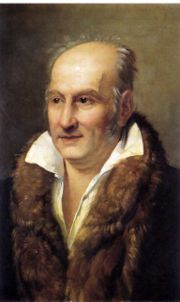
Gian Domenico Romagnosi
Encyclopedia

Italy
Italy , officially the Italian Republic languages]] under the European Charter for Regional or Minority Languages. In each of these, Italy's official name is as follows:;;;;;;;;), is a unitary parliamentary republic in South-Central Europe. To the north it borders France, Switzerland, Austria and...
philosopher, economist
Economist
An economist is a professional in the social science discipline of economics. The individual may also study, develop, and apply theories and concepts from economics and write about economic policy...
and jurist
Jurist
A jurist or jurisconsult is a professional who studies, develops, applies, or otherwise deals with the law. The term is widely used in American English, but in the United Kingdom and many Commonwealth countries it has only historical and specialist usage...
.
Biography
Gian Domenico Romagnosi was born in Salsomaggiore TermeSalsomaggiore Terme
Salsomaggiore Terme is a town and comune in northern Italy. It is located in the province of Parma, in the Emilia-Romagna region, located at the foot of the Apennines. It is a popular Spa town. The water is strongly saline....
.
He studied law at the University of Parma
Parma
Parma is a city in the Italian region of Emilia-Romagna famous for its ham, its cheese, its architecture and the fine countryside around it. This is the home of the University of Parma, one of the oldest universities in the world....
from 1782 to 1786. In 1791 he became the chief civil magistrate of Trento
Trento
Trento is an Italian city located in the Adige River valley in Trentino-Alto Adige/Südtirol. It is the capital of Trentino...
. In the late 18th and early 19th century Trento was successively under the rule of France, Italy and Austria. In 1799 Romagnosi was arrested in Innsbruck
Innsbruck
- Main sights :- Buildings :*Golden Roof*Kaiserliche Hofburg *Hofkirche with the cenotaph of Maximilian I, Holy Roman Emperor*Altes Landhaus...
during fifteen months by the Austrians on account of his alleged sympathy with the French, but he was acquitted. In 1801 the French occupied Trento
Napoleonic Wars
The Napoleonic Wars were a series of wars declared against Napoleon's French Empire by opposing coalitions that ran from 1803 to 1815. As a continuation of the wars sparked by the French Revolution of 1789, they revolutionised European armies and played out on an unprecedented scale, mainly due to...
, and he was raised to the position of Secretary of the Higher Council. He was successively professor of law at Parma, Pavia, Pisa and Milan. After the fall of Napoleon he lost his position at the Milan university, but continued to lecture till 1817. In 1818 he was again tried for treason at Venice, and again acquitted.
he died in Milan in 1835.
His most celebrated work is Introduzione allo studio del diritto pubblico universale (2 vols., Parma, 1805).
Although Romagnosi was not a scientist, he made some experiments with a voltaic pile
Voltaic pile
A voltaic pile is a set of individual Galvanic cells placed in series. The voltaic pile, invented by Alessandro Volta in 1800, was the first electric battery...
and its influence on a compass. He published two accounts of his findings in 1802, in Italian newspapers. It is sometimes assumed that he found a relationship between electricity
Electricity
Electricity is a general term encompassing a variety of phenomena resulting from the presence and flow of electric charge. These include many easily recognizable phenomena, such as lightning, static electricity, and the flow of electrical current in an electrical wire...
and magnetism
Magnetism
Magnetism is a property of materials that respond at an atomic or subatomic level to an applied magnetic field. Ferromagnetism is the strongest and most familiar type of magnetism. It is responsible for the behavior of permanent magnets, which produce their own persistent magnetic fields, as well...
, about two decades before Hans Christian Ørsted
Hans Christian Ørsted
Hans Christian Ørsted was a Danish physicist and chemist who discovered that electric currents create magnetic fields, an important aspect of electromagnetism...
's 1820 discovery of electromagnetism. However, his experiments did not deal with electric currents, and only showed that an electrostatic charge from a voltaic pile could deflect a magnetic needle.

